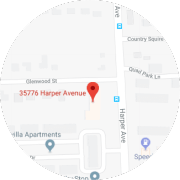Farsightedness (Hyperopia)
Hyperopia, unlike normal vision, occurs when the cornea is too flat in relation to the length of the eye. This causes light to focus at a point beyond the retina, resulting in blurry close vision and occasionally blurry distance vision as well. Usually this condition is undetected until later in life because the young eye is able to compensate for the hyperopia by contracting the internal lens of the eye.
Symptoms of Hyperopia:
- Blurry close vision
- Occasionally, blurry distance vision
Causes of Hyperopia:
- Heredity
Diagnosing Hyperopia
Many people are not diagnosed with hyperopia without a complete eye exam. School screenings typically do not detect this condition because they test only for distance vision. Your eye doctor can conduct a refractive evaluation to determine whether your eyes focus light rays exactly on the retina at distance and near. A visual acuity test will determine your ability to see sharply and clearly at all distances. Your eye doctor will also check your eye coordination and muscle control, as well as your eyes’ ability to change focus. All of these are important factors in how your eyes see.
Treatment of Hyperopia
Glasses and contact lenses are used by many for the temporary treatment of hyperopia. However, there are a number of vision correction procedures,m that can surgically reduce or eliminate hyperopia.
Nearsightedness (Myopia)
Myopia, unlike normal vision, occurs when the cornea is too curved or the eye is too long. This causes light to focus in front of the retina, resulting in blurry distance vision. Myopia is a very common condition that affects nearly 30 percent of the U.S. population. It normally starts to appear between the ages of eight and 12 years old, and almost always before the age of 20. As the body grows, the condition often worsens. It typically stabilizes in adulthood.
Symptoms of Myopia:
- Blurry distance vision
Causes of Myopia:
- Heredity
Diagnosing Myopia
Many times, myopia is diagnosed during school screenings. Sometimes parents notice that their children are having difficulty seeing street signs or the television. Your eye doctor can conduct a refractive evaluation to determine whether your eyes focus light rays exactly on the retina at distance and near. A visual acuity test will determine your ability to see sharply and clearly at all distances. Your eye doctor will also check your eye coordination and muscle control, as well as your eyes’ ability to change focus. All of these are important factors in how your eyes see.
Treatment of Myopia
Glasses and contact lenses are used by many for the temporary treatment of myopia. However, there are a number of vision correction procedures that can surgically reduce or eliminate myopia.
Blended Vision
During childhood, people with normal vision have the ability to focus on objects as close as their nose and also on objects very far away. They can rapidly, without conscious thought, switch focus from near to far vision. This is called accommodation. As each year passes, that ability to focus and to switch focus decreases. By the time most people reach their forties, they need an aid, such as reading glasses or bifocals, to focus on objects close up. This condition is called presbyopia.
Blended Vision is a technique where one eye (usually the dominant eye) is corrected for clear distance vision, and the other eye is corrected for comfortable near vision. Blended Vision allows a person to see close objects clearly with one eye and distance objects clearly with the other eye. The vision part of the brain tends to filter out the image from the eye that is not in clear focus, so those who have Blended Vision eventually do not pay attention to the eye that is not as clearly focused. Those who have Blended Vision are often able to see well enough both at distance and near to do things at any age without corrective lenses.
Blended Vision can be achieved with contact lenses or with vision correction procedures by correcting the non-dominant eye for near vision and the dominant eye for distance vision. If you are considering a vision correction procedure, your doctor can put you into Blended Vision contact lenses so you can try it before you permanently correct your eyes with Blended Vision.
Most people’s brains automatically get used to Blended Vision within a couple of weeks or months. In our experience, most people over the age of 40 to 45 who try Blended Vision and take the time to fully become accustomed to it, like it and find it very useful.
Strabismus
An eye patch is sometimes used to stimulate a “lazy” eye. Strabismus is a condition in which the eyes point in different directions. Types of strabismus include crossed eyes (esotropia), out-turned eyes (exotropia), or vertical misalignment (hyper or hypotropia). Turning of the eye may be constant or may show up only some of the time. Strabismus should be evaluated and treated.
Symptoms of Strabismus:
- Double vision
- Eyes that look in different directions
- Head tilt or turn
Causes of Strabismus
Strabismus is caused by a lack of coordination between the eyes. In children, the cause of strabismus is not known, although the condition runs in families and occurs more commonly in children with neurological problems.
In adults, causes of strabismus include injury to an eye muscle or the nerves controlling those muscles; head trauma; conditions such as diabetes or high blood pressure; loss of vision; an eye or brain tumor; Graves’ disease, stroke or other muscle and nerve disorders.
Treating Strabismus
Children with strabismus must be identified and treated at a young age in order to prevent permanent vision problems. In children, when the two eyes fail to focus on the same image, the brain may learn to ignore the input from one eye. If this is allowed to continue, the eye that the brain ignores will never see well. Children do not grow out of strabismus.
Treatment options depend upon the type of strabismus and may include glasses, patching one eye, prism lenses and/or surgery.
Uveitis
Uveitis is an inflammation that affects a part of the eye called the uvea. The uvea provides most of the blood supply to the retina. Uveitis causes spotty areas of scarring that can lead to vision loss. The degree of vision loss depends on the amount and location of the scarring. Uveitis is responsible for approximately 10% of the blindness in the United States.
Symptoms:
- Red eyes
- Blurred vision
- Sensitivity to light
- Dark, floating spots in the vision
- Eye pain
- Intraocular pressure that is higher than normal
Causes
Many conditions, diseases and infections can lead to the development of uveitis. In some cases the cause is unknown. Uveitis usually affects people between 20-50 years of age.
Diagnosing Uveitis
Uveitis is diagnosed with a thorough internal examination of the eye. Near and distance vision, plus intraocular pressure are also evaluated. In some cases, blood tests are performed to check for underlying disease or infection.
Treating Uveitis
The appropriate treatment for uveitis is determined by the severity of the disease and which eye structures are involved. Uveitis is typically treated with topical eye drops and/or oral medications to reduce inflammation. Sometimes, medication is required to lower the intraocular pressure, too. If complications are advanced, surgery may be necessary. After the inflammation has gone down, such as scar tissue, cataracts and glaucoma that have resulted from uveitis may need to be treated.
Pink Eye (Conjunctivitis)
Conjunctivitis is an inflammation of the conjunctiva, the thin, transparent membrane covering the surface of the inner eyelid and the front of the eye. The conjunctiva has many small blood vessels. It lubricates and protects the eye while the eye moves in its socket. When the conjunctiva becomes inflamed, this is called conjunctivitis.
Bacterial conjunctivitis, often called pink eye, typically causes swelling of the eyelid and a yellowish discharge. Sometimes it causes itching and/or matting of the eyelids. Bacterial conjunctivitis is very contagious and can be easily transmitted by rubbing the eye and then infecting household items such as towels or handkerchiefs. It is common for entire families to become infected.
Symptoms of Conjunctivitis:
- Red, watery eyes
- Inflamed eyelids
- Blurred vision and a sandy or scratchy feeling in the eyes
- Pus-like or watery discharge around the eyelids
- Matting of the eyelids
How Can Conjunctivitis Be Prevented?
Certain precautions can to taken to avoid the disease and stop its spread. Careful washing of the hands, the use of clean handkerchiefs, and avoiding contagious individuals are all helpful. Children frequently get conjunctivitis because of their poor hygiene.
If you or someone in your household has contracted conjunctivitis, follow these steps to prevent the spread of the infection:
- Every time you touch your eyes or face, including when using medicine in your eye(s), wash your hands thoroughly
- Wash any clothing touched by infected eyes including clothes, towels, and pillowcases
- Do not share makeup. If the infection is caused by bacteria or a virus, you must throw away your used make-up and buy new makeup
- Do not touch the infected eye because the infection will spread to the other eye
Diagnosing Conjunctivitis:
Doctor’s Allergy Formula provides an FDA- approved, non-invasive proprietary, a diagnostic test designed to objectively diagnose your specific allergies. This simple, painless (shot free) 3-minute test is covered by major medical insurance. The results of the test are read after only 10- 15 minutes. Once we identify what you are allergic to, we can create custom treatment protocols specific to your needs.
Treatment of Conjunctivitis
Antibiotic drops and compresses can ease discomfort and clear up the infection, normally within just a few days. Sometimes, the inflammation does not respond well to the initial treatment with eye drops. In those rare cases, a second visit to the office should be made. When there is a severe infection, oral antibiotics are necessary. If left untreated, conjunctivitis can create serious complications such as infections of the cornea, eyelids and tear ducts.

 586-792-3891
586-792-3891




